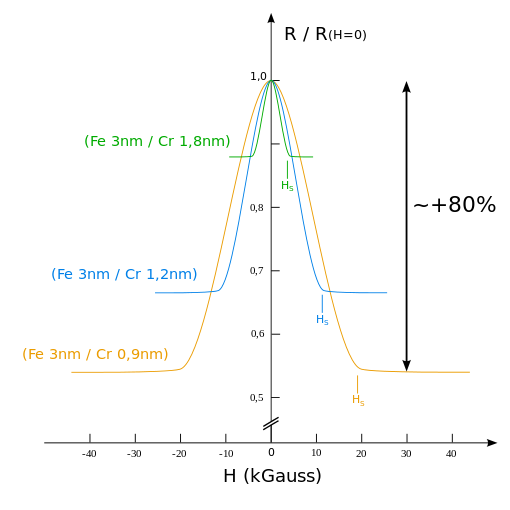This post sponsored by Texas Instruments.
We are all thankful and familiar with the capabilities that electronics bestow to humanity. In a short period of time, we’ve learned how to turn sand into gold, and the technology to make, use, and distribute electricity has literally taken us out of the Dark Ages into the light.
Virtually all electronic marvels are easily understood from a point of Ohm’s law, superposition, AC/DC circuit analysis, Norton, and Thévenin equivalents. Our representation of charge, current flow, and the key parameters of resistance, capacitance, and inductance tie up the world of electricity in a nice neat package that is easy to understand and teach.
But, there is a hidden realm of electronics. Instead of charge-based flow of currents, there is another world of behaviors and characteristics that revolves around spin. “Spintronics” is a relatively unknown and untaught area of electrical engineering that offers as many wonderful properties, behaviors, and effects as its charge-based counterparts.
One very useful property is Giant Magneto Resistance (GMR), which is a quantum effect. This was first observed and demonstrated using thin films of alternating magnetic and non-magnetic layers (Figure 1). With ferromagnetic materials used as layers, a magnetic field and orientation can be imparted to the individual layers in either a parallel (to current flow) or perpendicular (to current flow) orientation. In one case, the resistance is very low; in the other, the resistance is very high.

Figure 1: The orientation of adjacent layers of ferrous magnetic material can either allow or block current flow. This GMR effect allows this inherently non-volatile memory cell to be arranged in an array to create a spin-based memory device impervious to many charge-based hazards. (Source: Wikipedia)
Key here is that once a magnetic orientation (north or south) and direction (left or right) is established, the ferrite material “remembers” and preserves that state. In effect, this is a non-volatile memory cell. Fabbed on a silicon substrate as an array, it creates a spin-based memory array that is insensitive to EMI, RFI, and ESD for the most part.
This is why early forms of this Ferroelectric Random Access Memory (FRAM) technology were used in the first satellites and spacecraft (originally called core memory). While low in storage density compared to pure silicon approaches, it creates an ultra-highly reliable memory block that will survive the glitches that would corrupt ordinary silicon memory. And, it has minimal endurance limitations like Flash or EEPROM.
Texas Instruments licensed this technology and has placed blocks of spin-based memory alongside blocks of charge-based memory inside some of the leading processors for control and automation. The MSP430 family of microcontrollers with FRAM technology can leverage this technology and allow designers to create more highly reliable and fault-recoverable systems that use FRAM as a rock solid—a type of “you can always depend on me” memory.
This spawns the next generation of applications that can be designed to recover from faults, corrupted firmware, or registers from solar flares or EMPs. But, designers have to be aware of how to use this resource to maximize system survivability. For example, the smaller and lower-cost MSP430FR2033 can use the small 16 Kbyte block of FRAM for tightly written control code on an embedded sensor or actuator. Coupled with an effective internal or external watchdog, even if an electromagnetic event wipes out registers and corrupts run-time operations, it will always reboot with known good code (or diagnostics).
Another example of how this technology can change the design approach is with a high reliability data-logging design. Parts like the MSP430FR6989, for example, house 128 Kbytes of FRAM that can store basic code, as well as leave room for data samples. Built-in 12-bit A/D converters for single-ended or differential sensors make this an ideal candidate for mixed-signal designs.
All in all, over 100 variations of FRAM MSP430 software-compatible and scalable processors are ready to take on high reliability jobs. Texas Instruments provides a Power of FRAM Video overview as well, to introduce newcomers to how FRAM can be used. In addition, Texas Instruments has added a Compute Through Power Loss (CTPL) utility to its FRAM Utilities collection, enabling ease of use with LPMx.5 low-power modes and a powerful shutdown mode that allows an application to save and restore critical system components when a power loss is detected.
MSP430FR5959
For more information about this product, click here.
To request a sample, click here.

To buy now at Mouser, click here.
MSP430FR6989
For more information about this product, click here.
To request a sample, click here.

To buy now at Mouser, click here.
MSP430FR5969
For more information about this product, click here.
To request a sample, click here.

To buy now at Mouser, click here.
MSP430FR4133
For more information about this product, click here.
To request a sample, click here.

To buy now at Mouser, click here.
MSP430FR5969
For more information about this product, click here.
To request a sample, click here.

To buy now at Mouser, click here.
MSP430FR5739
For more information about this product, click here.
To request a sample, click here.

To buy now at Mouser, click here.
MSP430FR6989
For more information about this product, click here.
To request a sample, click here.

To buy now at Mouser, click here.
By: Jon Gabay
Advertisement
Learn more about Texas Instruments





